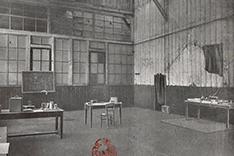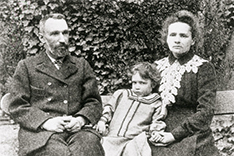Content
90th anniversary of Marie Curie's death

Marie Curie, 1911
Radiant icon of science
To this day, she is probably the best-known female scientist in the world: Marie Curie, who died 90 years ago. A woman of superlatives: she was the first to establish herself in cutting-edge scientific research, helped shape the beginning of the atomic age and was the only person to receive Nobel Prizes in physics and in chemistry.
The road to becoming an icon of science was long and rocky for Marya Sklodowska, who was born in Warsaw on 7 November 1867. At that time, "Congress Poland" was under Russian rule; Polish cultural development was suppressed, as was higher education for women. Sklodowska therefore went to study in Paris in 1891, where she was to remain for the rest of her life, without losing contact with her homeland.
In 1895, she married Pierre Curie, who became her partner and colleague. When Henri Bequerel discovered in 1896 (in the wake of Röntgen) that a uranium compound blackens a photographic plate, the Curies studied this phenomenon. It became the subject of their lives. Marie Curie (as she now called herself) would later baptise it "radioactivity". They researched whether other elements also emit radiation and finally came across the mineral pitchblende. The Curies realised that it was more radioactive than uranium and concluded that it must contain other radioactive substances.
Hard work in the wooden shed
The Curies received several tonnes of pitchblende waste from Bohemian mines for study purposes. A windy wooden shed, which had previously been used as a dissecting room, served as their "laboratory". There, they had to do hard physical work dissolving, boiling, filtering and analysing their research material in large vats.
"And yet the years in that miserable old hangar were the best, happiest years of our lives, dedicated solely to work," Marie Curie later recalled. "Sometimes I had to spend a whole day stirring a boiling mass with an iron rod that was almost as big as me. When we were cold, we would strengthen ourselves with a cup of hot tea, which we would take by the oven. We lived as if in a dream, filled with one single thing."
To keep their heads above water financially, they both had to teach on the side. Marie used the experimental demonstration method in her lessons - a novelty at the time. And the family grew: Their first daughter Irène was born in 1897.
Two new elements
The scientific success soon materialised The Curies isolated two unknown elements from the pitchblende. Marie named one "polonium" after her home country and the other "radium". She received her first scientific prizes, but was already experiencing physical impairments as a result of working with the radiating material, the health risks of which were not yet fully known.
The year 1903 brought the final breakthrough: Marie received her doctorate with her thesis "Recherches sur les substances radioactives" under Becquerel and all three were jointly awarded the Nobel Prize in Physics for the development and pioneering work in the field of spontaneous radioactivity and radiation phenomena. It is said that the Academy originally only wanted to honour Pierre Curie and Bequerel, but then bowed to Pierre's protest, who insisted that his wife's contribution be honoured. Marie became the first woman to receive a Nobel Prize.
Incidentally, Marie Curie deliberately did not patent her process for isolating radium, so it is said, so that the scientific world could continue to research it unhindered (however, according to French law at the time, she would not have been allowed to apply for a patent - only her husband...).
Single widow, two daughters, two Nobel Prizes
The love and success story of the Curie couple came to a tragic end when Pierre died in a road accident in 1906. At the age of 38, Marie was a widow and mother of two young daughters who, despite winning the Nobel Prize, had to fight hard to assert herself in the male-dominated scientific world. And she succeeded. Initially, she was allowed to take on her late husband's teaching duties as a substitute, but two years later she became France's first full professor at the Sorbonne.
While her reputation grew worldwide, she had a very hard time in France at times. She was refused admission to the Academy of Sciences. A media smear campaign against the "foreigner" broke out in 1911 when her relationship with Paul Langevin, a married colleague and former student of her husband, became known. It got to the point where an angry mob besieged her house and she and her children had to seek shelter with a friend. The affair culminated in court cases and duels.
But in the same year, Curie published her work "Traité de Radioactivité" and received her second Nobel Prize - this time in chemistry, for the discovery of radium. To this day, she is the only person to have won the prize in two scientific categories (the chemist Linus Pauling won his second prize in the "Peace" category).
With the X-ray mobile to the front

EM 012931028
On the eve of the First World War, Curie was a world-famous scientist. In 1914, she became head of the new Radium Institute at the Sorbonne, which developed into one of the world's leading centres for nuclear physics. Today it bears her name (trademarked, of course; see EM 003515673, IR 1120170, IR 1557383). She was a key participant at the influential Solvay symposia right from the start - and remained the only woman for decades until her daughter and Lise Meitner were also allowed to attend in 1933. Irène Curie worked at her institute and also received the Nobel Prize for Chemistry together with her husband Frédéric Joliot in 1935.
During the world war, Curie developed a mobile X-ray station together with Irène. She obtained a driving licence and personally drove the car to the front to examine injured soldiers on site. On her initiative, around 200 radiology centres were gradually established during the war.
A gram from the White House
This is why her institute lacked radium after the end of the war. Thanks to the campaign of an American journalist, money was collected for her in the USA. In 1921, US President Harding presented her with a gram of radium worth 100,000 dollars for her institute at the White House. In 1929, she travelled to America again and received more radium, this time for a new institute in Warsaw.
Even on these PR trips, during which she was showered with honorary doctorates and awards, Curie always appeared calm, modest and unpretentious. Albert Einstein is said to have said of her that she was the only person who did not let fame go to her head.
But her lifelong involvement with radioactive material ruined her health. Marya Sklodowska Curie died on 4 July 1934 in Passy and was buried next to her husband. When France decided to transfer their remains to a grave of honour in the Pantheon in Paris in 1995, they had to be buried there in lead coffins - their remains still radiate. Even Curie's working papers and even her cookery book are still radioactively contaminated and to this day can only be viewed with protective clothing.
Text: Dr. Jan Björn Potthast; Pictures: Generalstabens Litografiska Anstalt Stockholm via Wikimedia Commons, Pierre Curie / Public domain, via Wikimedia Commons, via Wikimedia Commons, Benjamin Couprie / Public domain via Wikimedia Commons, DPMAregister, Public domain via Wikimedia Commons
Last updated: 16 April 2025





Not only protecting innovations
Social Media